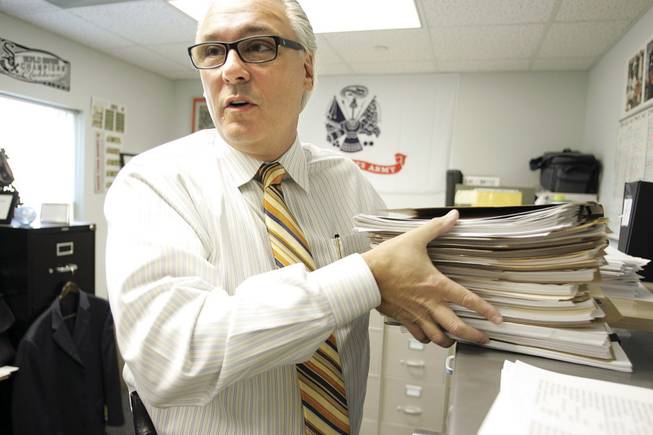
Sgt. Thomas Newsome, who works in the Compliance Enforcement Division at the Department of Motor Vehicles, shows a month’s worth of identity fraud cases flagged by facial recognition software. With the technology, Newsome’s team has made 84 arrests for identity theft since January.
Wednesday, Aug. 26, 2009 | 2 a.m.
Sun coverage
Beyond the Sun
Armed investigators wearing brass badges at the Department of Motor Vehicles building on West Flamingo Road scan the thousands of driver’s license photos Nevadans smile for every day, looking for fraud.
Every week, with help from a computerized facial recognition program, they catch dozens of people attempting to get licenses in someone else’s name, though few of these identity-theft artists approach the current record holder — a man who had 38 licenses, in 38 names.
The man, and his many identities, is now the subject of a Secret Service investigation, said Thomas Newsome, a sergeant in the DMV compliance enforcement division. Since January, Newsome and fellow DMV investigators have arrested 84 people on identity theft and fraud charges. They have 88 additional arrest warrants out, and dozens of open cases, piling up in manila folders on their desks.
This is the post-9/11 DMV — that purgatorial, bureaucratic world of waiting lines, records and photos — re-envisioned as a front line in the war on terror. Ever since hijackers boarded airplanes carrying state ID cards — including Florida, New Jersey and Virginia — some obtained fraudulently, there’s been increased scrutiny of the DMV process; who gets licenses, and how, and how many.
The Nevada DMV fraud investigation unit was formed in 2003, in part as a response to 9/11. And while it’s questionable whether the six fraud investigators working under Newsome today are halting would-be terrorists, it’s clear they’re finding a good number of identity thieves.
On a typical day, DMV investigators catch eight to 10 people trying to get licenses with false names or stolen identities. Some are just teenagers trying to get a 21-year-old’s license. Others are illegal immigrants attempting to pose as U.S. citizens. And some are felons trying to bury prior bad acts, or criminals trying to commit new crimes under assumed identities.
One guy applied for a license with a stolen Mexican birth certificate, hopeful his rebirth as a foreign national would conceal his U.S. status as a sex offender. Another guy was caught after using the same stolen ID for 35 years, even paying his victim’s child support to avoid capture. A third guy applied for a new license so he could continue to commit large-scale check fraud — he confessed to stealing tens of thousands of dollars in a multistate crime spree, Newsome said.
In the past, DMV investigators had to rely on tips and suspicious documents to identify fraud. Facial recognition software has changed that. The computer program can scan roughly 1.6 million photos in the Nevada DMV database for similarities in the same time it takes for an investigator to sip coffee, if not faster.
Every evening, the facial recognition software cross-checks DMV photos taken that day (3,000 or 4,000 on average) against the databank of ID and license pictures, using an algorithm to detect facial similarities through features: The distance from chin to lip, from eye to nose, and so on. If the program finds a similar face in the records, it’s flagged for a DMV employee to review the following morning.
There are on average 200 possible matches to review every morning. A particularly generic face may look like 15 others, and so each match must be sorted through for siblings, twins and look-alikes. Sometimes there are matches within the matches. And every match is a new case.
In March, three months after the facial recognition system was launched in Southern Nevada, the number of ID fraud arrests had more than doubled from the same period in 2008, and the number of licenses and ID cards canceled for fraud had tripled. In the past seven months, DMV investigators have opened just over 900 fraud cases, and continue to open a few dozen every month.
Nevada is one of 31 states using the facial recognition software developed by Connecticut-based L-1 Identity Solutions, a company spokesman said.
Meanwhile, a second computer system is at work, one that checks photos as they’re being taken. Come in for a new photo, and the DMV employee behind the camera will compare the latest picture with prior photos on record. If the faces don’t match, there’s a chance someone isn’t who they say they are.
Local law enforcement agencies, like the U.S. Marshals or Metro Police, sometimes give DMV investigators photos of people they’re looking for — a match can determine the suspect’s identity, or whether they have a false ID.
When the facial recognition software was first installed, DMV investigators ran photos of some of the country’s most wanted criminals through the database. They didn’t get any hits, but they keep checking.

Join the Discussion:
Check this out for a full explanation of our conversion to the LiveFyre commenting system and instructions on how to sign up for an account.
Full comments policy